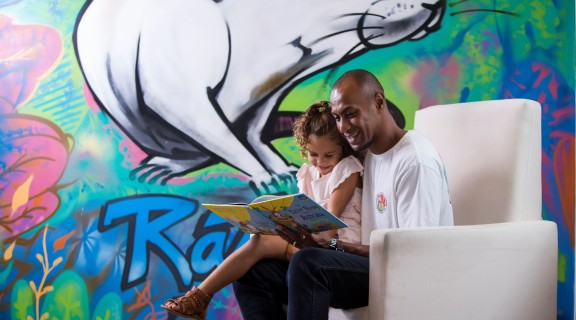
Colour their world
16 March 2022 | State Library of Queensland
Recognising colours and identifying their names, is an important stage in children's development. Learning colours provides a new and exciting way for children to recognise and describe the world around them.
Teaching colours is best done through playful everyday life experiences. Talk about the colour of the socks you are dressing them in, or the cup they choose to drink from.
Start by including the colour words in your conversations: "We are going in Mummy's blue car" or "You’re bringing the red bag". The more children hear the names of different colours, the easier it will be for them to integrate them into their speech.
Some children learn better if you name the object and then add the colour: "You have chosen the cup. It’s green!"
Encourage your children to add a colour description to the things they see and do: "You’re wearing your hat. It's yellow!"
Start with two or three colours and ask children to pick a colour. Praise their efforts even if they get it wrong: "Good try. This is the red one."
Once children master the primary colours of red, blue, and yellow, you can begin introducing secondary colours like orange, purple, and green, followed by shades of colour such as aqua and lavender.
As children learn the concept of colour, you can begin encouraging them to name the colours themselves. Use identical objects that come in different colours to teach colour differences, like a basket of pegs.
Point out real life objects that are the same except for colour. Ask children to collect the green apples or bring the red ball and put it in the blue bag. Pick a new colour to focus on each week and teach your child about that colour before moving to a different colour.
Activities for colour practice
Playing games makes colour learning fun and helps little ones retain information. Here are some ideas that make colour learning fun:
- Ask children to look for items in a particular colour. Give young children a sample such as a yellow block as a reference point.
- Make up their own book of pictures in their favourite colour
- Play follow the leader and only hop on the red dots/blue cushions etc.
- Encourage them to point to items in their favourite colour as you read a book.
- Invite children to sort a basket of socks, blocks, pegs etc. by colour.
- Provide art supplies for children to experiment with colour mixing.
- Play 'I Spy' with colours - "I spy with my little eye, something yellow!"
- Use coloured sand or rice for tactile play .
- Make slime or play dough in their favourite colour.
Explore colour through books
Here are some titles that you can use to talk about colours. Remember that saying the names of the colours helps build their vocabulary and understanding. Your child will soon be using colours in their everyday conversation.
- The Coloured Echidna by Eunice Day
- Brown Bear Brown Bear by Eric Carle
- The Day the Crayons Came Home by Drew Daywalt
- Danny Blue’s Really Excellent Dream by Max Landrak
- Little Fish’s Colours by Lucy Cousins
- Red House, Blue House, Green House, Tree House by Jane Godwin
- Pete the Cat: I Love My White Shoes by Eric Litwin
- Little Green Peas by Keith Baker
Your local public library may have some of these titles or others on colours. For help with choosing a great book on colours ask library staff for assistance.
Comments
Your email address will not be published.
We welcome relevant, respectful comments.